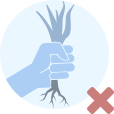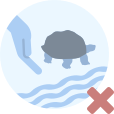
Go to our visitor centres, information points and ecomuseums to get the most out of your visit.
The presence of the sea and the beach around the mouth of the Guadalhorce River constitutes an element of great environmental value. The coast improves and further enriches some of the already important natural aspects of this area, such as the landscape and the ecology of the marsh and coastal systems of this environment. In fact, the border effect increases the biodiversity in the area between the marine environment and the coastal lagoon environment, which really increases the chances of finding certain species of wild fauna and flora linked to the sands of the beach and others that are strictly marine. Thus a unique “catalogue" of species can be observed. It is a good idea, therefore, to get closer to the sea, as long as there aren’t severe storms, since it is worth trying to discover what we can observe next to it.
This observatory, located on land reclaimed from the sea and protected by breakwaters, is basically designed to look out over the sea and the beach and is the final milestone and culmination of the Rio Viejo signposted trail. Like the rest of the observatories in this natural setting, it was inaugurated in early 2009 after the activities carried out by the central administration to channel the Guadalhorce River, with a view to preventing floods and for the hydrological and environmental restoration of the mouth of the river and is currently managed for public use in the protected Protected Area. It consists of a construction with a circular stone base of approximately 40 m², it has no roof and is semi-open towards the sea with a one-metre high wall along this section, it is enclosed on its northwest face by another wall of the same nature but higher (just over 2 metres) and has an opening for access and entry. It has two long benches with space for about 10 people, also made of mixed stone, providing us with a great view of the beach at the mouth of the river as well as the calm waters of the Mediterranean sea, which is only 18 metres away.
With a little patience and the help of binoculars or telescopes, we may surprise some of the animals that gather near the seashore, scampering through the intertidal area in search of small prey and especially worms, isopods and amphipod crustaceans. Such is the case of certain waders occasionally found on this stretch of coast and that we may be able to identify such as sanderlings, oystercatchers, plovers, bar-tailed godwits and Eurasian whimbrels. One species even nests on the sands of the beach, the Kentish plover, which is why we must not enter the fenced-off area in which the samophilous vegetation is recovering and where the nests of this small caradrid are usually located.
It goes without saying that the kings of the birds in this area are the seagulls, especially at the end of August and during the month of September, observe them carefully to see if they are the abundant and noisy black-headed gull, yellow-legged gull or lesser black-backed gulls or if, on the contrary, they are other rarer and more unique species, such as Audouin's gulls, slender-billed gulls or Mediterranean gulls. It is also not surprising that from this privileged observation point, we see the flight of ospreys mainly during winter, and with even more luck and a lot of patience it is possible to discover some Common scoters swimming near the swash, this being one of the few sea ducks in our latitudes. Other species of unique birds that can be seen in the sea from this observatory are the lesser auk, a close relative of the puffin although less conspicuous, as well as northern gannets and sandwich terns, and inland it is common to see the passage of numerous groups of cetaceans, which come to the coast in search of the fish that come to eat at the mouth of the river.
Please, use the facilities responsibly, respecting the environment and other users, avoiding unfair behaviour so that together we can use and enjoy the facilities in accordance with the wonderful environment that welcomes the visitor. No entry with animals that may be a danger to passers-by or other animals, please bear in mind that dogs must be led by people of legal age and kept on a lead with the appropriate identification (if they exceed 20 Kg they must be provided with a muzzle and a resistant and non-extensible lead). Enjoy the views from the observatory in silence if possible or without raising your voice, since this way the chance of discovering the inhabitants of the nearby beach are infinitely greater.


The observatory is accessed on foot via the Río Viejo path, along which we will travel for 1564 metres from the beginning. To get to the point where this path begins from Malaga city, heading west along Avenida de Andalucía, we take the MA-20 Algeciras-Cádiz motorway. If, on the other hand, we leave the city on Avenida de Velázquez, we will initially continue along the MA-21 road towards Torremolinos, turn right at exit 4A, then take the MA-22 motorway to the port of Malaga, as signposted. We leave this road at a roundabout taking the second exit to the left towards "La Azucarera", and immediately afterwards we will return to the MA-21 but this time heading towards Malaga, although we will leave this road almost immediately, turning off to the right on the exit towards the MA-20 Algeciras-Cádiz motorway.
In both cases, either coming from Avenida de Andalucía or Avenida de Velázquez, we will continue along the MA-20 motorway until Km 4, where we turn right at exit 3 (San Julián and Guadalmar). Continuing towards Guadalmar we find a roundabout at the entrance of the urbanisation where we will take the exit to the left, along the Street Guadalhorce. When we see a church we should park the vehicle (GPS coordinates: longitude 4 ° 27 '52.5 "West and latitude 36 ° 40' 10.1" North). We continue, on foot, along the aforementioned Guadalhorce street for about 300 metres until we come across a dirt track that ascends to the left next to a stone portico with a chain. Once at the top of the river berm, we will walk northwest for another 260 metres, until we reach the starting point of the trail.

Go to our visitor centres, information points and ecomuseums to get the most out of your visit.

Do not disturb or feed the animals. You would negatively alter their behavior.

Check the weather forecast before starting your activity.

Bring water, sun protection, suitable clothing and footwear.

Don't forget your binoculars.

Follow the recommendations and comply with the regulations at all times

Respect the facilities put at your disposal. We all pay for its maintenance.

Help prevent fires. Do not throw cigarettes or any other object that produces combustion.

Trash doesn't come back alone. Take it with you to the nearest container. Reduce, reuse, recycle.

Noise is another form of pollution. In silence you will enjoy your experience more.

Live respectfully with the locals and other users. Respect private property.

Facilitate use for people with special needs.

By consuming local products and counting on local companies, you will contribute to rural development.

Practice responsible tourism and committed to the environment. Be a true ecotourist!

Never leave your pet in the wild. It would endanger the flora and fauna of the place.

Get around in a sustainable way: public transport, bicycle, on foot, electric or shared vehicle ... Park in the designated places

Do not leave a trace of your passage through nature. The best memory you can take with you is your own photograph.

Your safety is our concern, but it is your responsibility.

The conservation of natural spaces is also in your hands. Thank you for your collaboration!

Find out in advance about the possible existence of hunting activity and remember that all public use facilities are declared safety zones.